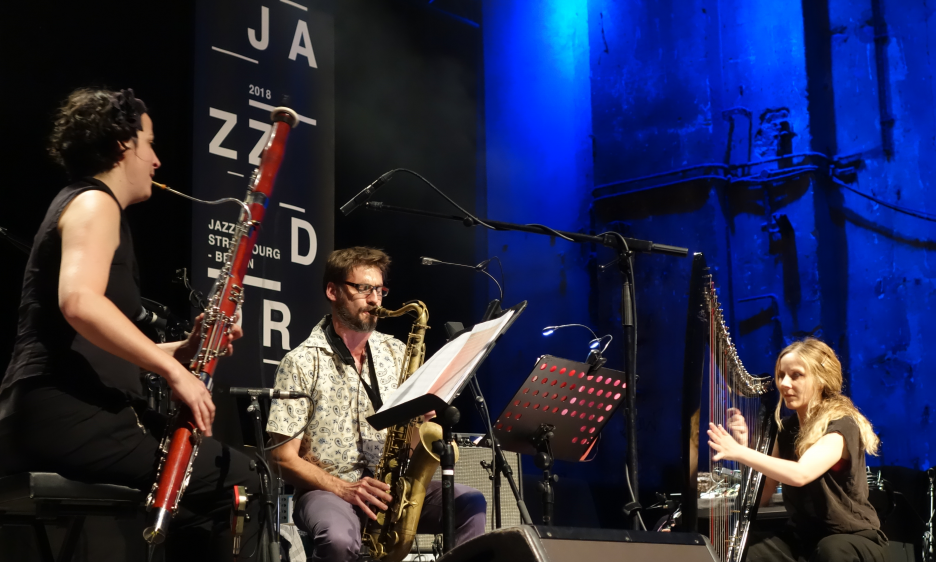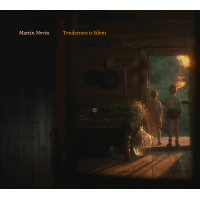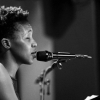Home » Jazz Articles » Live Review » Jazzdor Berlin
Jazzdor Berlin

Jazzdor Berlin
June 5-8, 2018
Jazzdor Berlin is a satellite of the Jazzdor Festival of Strasbourg founded 31 years ago. This year's 12th edition of the Franco-German festival held as usual at Kulturbrauerei, an abandoned brewery in Berlin borough Prenzlauer Berg, presented 11 groups with 40 musicians during four nights. Among the 40 musicians were five female musicians: Sophie Bernardo, Airelle Besson, Silke Eberhard, Andrea Parkins and Rafaelle Rinaudo. They played mostly in egalitarian groups.
The festival brings bi-or multinational collaborations and introduces new as well as existing French configurations to the Berlin audience in a fine balance of younger and older musicians. Besides the French musicians, this year's edition had nine musicians from Germany, two from Belgium, and one each from Switzerland, Italy and the US. Some artists return in different combinations and constellations, and regularly there are new faces and configurations. This year's edition started with pianist Roberto Negro's trio DaDaDa and concluded with baritone veteran Francois Corneloup's quintet.
Personal highlights
My personal favorites of this year were a wondrous sound unit of bassoon, harp and saxophone, a surprising and intense pointillist trumpet-piano-drums trinity and an octet with a special twisted charm, vitality and joy of playing the music.The bassoon-saxophone-harp unit of Sophie Bernado, Hugues Mayot, Rafaelle Rinaudo, called Ikui Doki, was a marvelous affair, captivating not only because of its attractive sound, or the entanglement of their respective instruments and their splendid musical humor, but above all because of the way the three musicians went for, and into, their unfolding stories (for characteristics of some pieces see the slide show at the top of this article). I knew Sophie Bernardo already from her strong contribution in several concerts with Eve Risser's great White Desert Orchestra (WDO) and harpist Rafaëlle Rinaudo from her daring duo with WDO bassist Fanny Lasfargues. It was a joy to see them joining forces with versatile reedist Hugues Mayot of the same generation and make something so strong out of it. Bernardo is a sassy, imaginative improvising musician and Rinaudo knows the ropes, the rough and the tender, the stormy and the serene side. She used the vibrations of the strings and percussion on her instrument (and body) in a marvelous way. Saxophonist Hugues Mayot operated with great sensibility here in terms of tone and presence.
French trumpeter Airelle Besson and the topnotch Cologne pianist Sebastian Sternal and drummer Jonas Burgwinkel started to work as a trio a while ago. However the trio constellation has not actually performed live so often as yet. The trio came forth from a tour together with Parisian bassist Ricardo del Fra four years ago. Musically they seemed to be destined to work with each other, but in practical terms it was difficult until now for them to work with each other more regularly. Jazzdor was good luck for them and it was apparent they were eager and highly motivated to play together. Compositionally and in terms of performance dynamics, interaction and liveliness, it became an extraordinary thing, enriching for all three musicians. The beautifully shaped music was remarkably fresh—a real nice surprise and more than worthwhile to be presented and heard elsewhere in the future.
The aforementioned octet is the TransEuropeExpress of renowned Cologne pianist Hans Lüdemann comprising four high-profile German and four French musicians: Silke Eberhard, Ronny Graupe, Dejan Terzic, Théo Ceccaldi, Yves Robert, Julien Pontvianne, Sébastien Boisseau. Saxophonist Julien Pontvianne is a new face. Dependent upon availability, he alternates with Alexandra Grimal.
The ensemble has previously played the Jazzdor Festival in 2014 (Berlin) and in 2015 (Strasbourg). Its first album, aptly entitled Polyjazz, was recently released by renowned Budapest BMC label. The music opens a new chapter of multiform interweaving, collaging and intertwining of heterogeneous approaches and ways of entering, different layers, voices and ensemble parts in playful competition with each other.
As such it appeared to be much more open, light and more flexible and permeable than former tightly defined and directed attempts. Pointed titles of pieces, composed by members of the ensemble, such as "Zwickmühle" (Lüdemann), "Traum im Traum" (Terzic), "Schwarz in Weiss" (Lüdemann), "Des Arbres sous les pieds"(Robert) and "Trois fois rien"/"Nichts und wieder nichts" (Ceccaldi) speak for themselves and indicate the nature of the game. It turned out as a stimulating, challenging and enjoyable complexity, most significantly manifested in the grandioso encore with Ceccaldi's piece "Trois fois rien," that Ceccaldi himself conducted with theatrical verve.
TEE is one of the most stable and significantly developing French-German ensembles. It has yet to conquer its adequate place in the French and German scene respectively at more of those countries' venues and festivals tying in with the times that German pianist Joachim Kuhn played a prominent role on the Paris jazz scene.
Presence of presentation
Music like this lives by two things. Firstly, good acoustics, and secondly, lively, playful and personal performance. A good sound quality that fully transports its subtleness as well as the contrasting bright loudness, the layers and overlaps etc. is crucial. In the Kesselhaus hall a lot of its plasticity and deep bone unfortunately became flattened and lost. Also the performativity of the music making is of essential importance. The manner Ceccaldi conducted his piece "Trois fois rien" was a good example of what's meant by performativity. Ceccaldi is a master of this. I am pretty sure a neurologist can measure this in terms of arousal level and brain waves of the listener. Lüdemann himself also was quite mobile during the performance while the other musicians were less mobile in terms of exteriorizing the punctuation and movement of sound and its line. It is additionally obstructed by the high stage that forms a perceptual barrier while the simple seating as a whole is positioned at ground level. It is not for nothing that the audience partly follows the proceedings standing at the back of the hall. It is obvious that the hall's setup is oriented to a different kind of musical experience.By this I do not mean that musicians have to show hyper expressive behavior. Exteriorization can also be very subtle and minimal. Most important is the effect on the perception of the listener. (S)he should be enabled to subconsciously notice/register the interactional traces. Eve Risser's White Desert Orchestra is a good example for the working of this. It is above all a question of collective awareness of this aspect. Emplacement and alignment of musicians/instruments on stage is also an important factor. For instance in TEE the drummer was placed almost invisible in the back on the right side (audience view) while in the WDO the drummer is mostly placed visible in the center in the front line.
Context/Platform/Breeding Ground
As already mentioned French festival Jazzdor Berlin is a bilateral affair with some offshoots too. This year's edition had a Paris—Rome -Zürich -Brussels—Cologne—Berlin—New York axis. Besides the basic musicians from Paris there were percussionist Michele Rabbia from Rome, trombonist Nils Wogram from Zürich, drummer Lander Gyselinck and keyboard wizard Jozef Dumoulin from Belgium, drummer Jonas Burgwinkel, pianist Pablo Held, bassist Robert Landfermann as well as the pianists Hans Lüdemann and Sebastian Sternal from Cologne, drummer Yorgos Dimitriadis, reedist Silke Eberhard, guitarist Ronny Graupe and drummer Dejan Terzic from Berlin and accordionist Andrea Parkins from New York. Jozef Dumoulin (B/F) belongs to a group of musicians that are present in two countries, in two scenes as saxophonist Robin Fincker (F/UK), saxophonist Daniel Erdmann (D/F), percussionist Jim Hart (UK/F), cellist Anil Eraslan (F/D) etc.. Jazzdor not only represents these interconnections at the Berlin edition and the Strasbourg mother edition, Jazzdor also fuels and fires these like in a neural network thereby strengthening the connections and initiating new branches.If a European country wants to present and promote its musicians in another European country it is an obvious and natural approach to go to that country and match and combine musicians from both countries to foster enduring exchange and artistic development. That is what Jazzdor has done for the past 12 years. Other countries have different, often unilateral approaches or leave it to the musicians themselves to join forces and collaborate. It is a mystery why France still is the only country consequently following the bilateral route. My impression is that this and other measures actually facilitate access of French musicians to foreign audiences, labels and collaborations with musicians in other countries and consequently becoming a known or even popular name. Germany, but also Eastern European countries, clearly show that. On the other hand, you can see that for example musicians from Eastern Europe migrate(d) to France and asserted themselves on the French scene.
An event such as Jazzdor Berlin is embedded in a larger interlocking supportive infrastructure, as the part Jazz Migration, which was created in 2002 for young upcoming musicians and groups. Every year Jazz Migration chooses four units to give training to in order to help build their career nationally and internationally, and to support them by organizing concerts in venues and at festivals (about 10 for each unit). The yearly chosen units are also adopted by a major venue or festival.
Participation at events like Jazzdor Berlin is one of the possibilities. This year two of the four selected groups, Ikui Doki and Novembre, participated in Jazzdor Berlin to give them international exposure. Ikui Doki is adopted by Paris Jazz Festival and the group Novembre by festival Banlieue Bleu.
Conspicuously some of the musicians of the two groups have performed earlier at Jazzdor Berlin (cumulative effect). In that context, and with its long-term approach, Jazzdor can be considered a breeding ground for the artistic growth of young-up-and-coming as well as for established musicians and groups (see also my review of Jazzdor 2017 Strasbourg).
Reach in/reach out
The other eight units went with their music along a couple of different trails. They reworked folk music sources (Bedmakers, Michel Portal 5), played energizing straight ahead (François Corneloup Quintet), worked round spurt and slowing down (Roberto Negro DaDaDa), dealt with heavy real time creation (Dimitriades/Lemoine/Parkins) and did their thing with playfully orchestrating particles and giving it transient shape (Pablo Held Trio, Novembre).Pianist Roberto Negro's DaDaDa unit with the unbeatable Émile Parisien and the forcefully beating, as well as subtly rustling and soughing, Michele Rabbia opened, set the standard, fired things up and triggered the next group, The Michel Portal Quintet. Bass clarinetist Michel Portal (1935) is (still) a driving force in the French jazz/music scene and the most prominent one on his instrument together with Louis Sclavis. He cannot be pinned down to a definite direction, style or whatever and thus has never become father figure for any specific kind of music. From hard core classic to deep funk, blues and Latin, he played and plays everything. He constantly seeks for fresh blood in his group(s) and collaborates with musicians from all generations, French or otherwise that have something to say and to contribute, like new French accordion wizard Vincent Peirani, French saxophone canon Emile Parisien or amazing Belgian drummer Lander Gyselinck. The most longstanding musicians in his quintet (and other units) are pianist Bojan Z and bassist BrunoChevillon, both heavyweights of the French scene. The new colors he recently started to inject come from German trombonist Nils Wogram (1972), long time duo partner of Bojan Z, and new European revelation, thirty-year-old drummer Lander Gyselinck from Belgium. The quintet played a colorful and greatly flowing set with lots of Cuban and other Latin tinges too.
Next night was opened by renowned trio of pianist Pablo Held (1986) bassist Robert Landfermann and drummer Jonas Burgwinkel from Cologne. Underway now for more than ten years, with ten albums on its sleeve, it is one of the most solid younger piano trios in Europe (see my review here). With its last album Investigations they made their debut for UK-based label Edition Records. The trio that regularly joins forces with electric guitarist John Scofield or acoustic guitarist Ralph Towner should have performed with Brazilian-French guitarist Nelson Veras but Veras could not make it due to an accident and a finger injury. With Veras' fate in mind, these three close musical friends entered another of their highly sophisticated conversations, freely switching between topics and thereby fine-tuning, shifting and twisting their expressions in a way that rendered new, uncommon aspects and insights. They are so close and familiar with each other that nothing seems impossible in terms of twisting and turning around. It happens to a degree that they become almost TOO good!
What If, the quartet of French up-and-coming saxophonist Hugues Mayot, comprising unmistakable keyboard wizard Jozef Dumoulin, bassist Joachim Florent and drummer Franck Vaillant concluded the night with a strangely disconnected set. The music was both right and not right in a way that was hard to pinpoint. It turned out that the musicians had a lot of heavily exhausting bad luck during their travel to Berlin. Next day when Mayot was performing as part of Ikui Doki he clearly had recovered and played a strong and subtle set with that unit.
The performance of drummer Yorgos Dimitriadis, saxophonist Philippe Lemoine and accordionist Andrea Parkins in between the trio Ikui Doki and the large ensemble of Hans Lüdemann was a quite different affair. The three musicians worked entirely in real time creation mode (zero fixed things in advance) generating, electronically processing/manipulating and shifting dense inscrutable textures such that listeners' usual apprehension ceased to work. They were compelled instead to take (in) the 'massive' sound and follow the unfolding process and the hidden inner life of the thicket in a different way. The trio's music making although seeming a bit lost in between the other groups' activities nonetheless had strong repercussions on the audience, but it is hard to describe the impingement (for my personal impression see the slide show on top of the article).
Who are these musicians and what brought these three musicians together to play at Jazzdor Berlin? Greek drummer Yorgos Dimitriadis and French saxophonist Philippe Lemoine are both active members of the Berlin impro-scene. Lemoine also works in Marseille and Dimitriadis worked for more than a decade in Paris. Lemoine has been a member of Orchestre National du Jazz under the direction of Claude Barthelemy from 2002-2005 and he has a quite intensive collaboration with drummer Yorgos Dimitriadis in Berlin. Andrea Parkins is a multidisciplinary artist from New York who, by various means, wields a sonic language that is both fractured and fluid. Her visual materials include objects, video, drawings and photographs. In this case Jazzdor zoomed in on older and longer existing Paris-Berlin traces.
Jazzdor's last night in Berlin started with Novembre, a new young French quartet consisting of saxophonist Antonin-Tri Hoang, saxophone, pianist Romain Clerc-Renaud, bassist Thibault Cellier and drummer Elie Duris. The group was selected for this year's Jazz Migration program already mentioned above. Antonin Tri Hoang is a key musician of the younger French generation and already a familiar face for Jazzdor. He previously performed with Eve Risser's White Desert Orchestra and as part of German alto player Charlotte Greve's Liesbeth Quartet. Novembre had the same kind of free discursiveness as the Pablo Held trio and some of the polyvalent side of the music of Lüdemann's TEE ensemble, but the quartet gave it shape with higher pressure and sharp turns in a much more grinding manner. The group has developed its very own approach and voice of dynamic transitional diversity, of scraping and reformulation, which holds promising potential.
The Bedmakers played in a line-up of French-English saxophonist Robin Fincker, French violinist Mathieu Werchowski, Irish bassist Dave Kane (taking the place of Pascal Niggenkemper for that occasion) and French drummer Paul Rogers/Robin Fincker/Fabien Duscombs. It is a remarkable group in two respects. First, the group has a multinational line-up and consists of musicians that are at home in two scenes, like French saxophonist Robin Fincker who is member of the London loop collective, or German-French bassist Pascal Niggenkemper who works in the New York scene as well as in the French scene. Apparently, a lot of musicians of this kind appear at Jazzdor. Second, the group has applied and dedicated itself explicitly to Anglo-American folk music (US-American guitarist John Fahey, Irish flutist Matt Molloy, English guitarist Bert Jansch etc.). The influence of folk music is often implicit but in the case of the Bedmaker's "Tribute To An Imaginary Folk Band" it is programmatic and explicit witness the group's recent album, a co-production of French label Freddy Morezon and English Babel label of Oliver Weindling. It is a truly refreshing vital note these days. The title alludes to the French movement Folklore Imaginaire from more than 30 years ago but the Bedmakers add something that is in a way long overdue, the improvisational elaboration of well-known strong melodic material. It goes much further than, for example, the (one-time) pairings of Robin Williamson with improvisers such as violinist Mat Maneri, bassist Barre Phillips or saxophonist Paul Dunmall. Bedmakers' inspired and inspiring turn resulted in a forceful Jazzdor performance.
The final concert was renowned French baritone saxophonist François Corneloupe with his all French quintet comprising trombonist Simon Girard, pianist Sophia Domancich, bass-guitarist Joachim Florent and drummer Vincent Tortiller, two musicians from the younger and two musicians from the older generation. Corneloupe is one of these few dedicated and passionate, fluid and raucous baritone players. In this quality he has intensely collaborated with likes of bassists Claude Tchamitchian , Henri Texier, pianist Francois Raulin and reedist Sylvain Kassap . As expected, the appearance of this line-up became a full blast and a splendid conclusion of the festival with a remarkable contribution of young trombonist Simon Girard (1985).
Conclusion
Jazzdor Berlin again provided valuable insights in artistic development of young-and-upcoming musicians/groups, in new concepts/approaches and new perspectival collaborations. However, to maintain Jazzdor's attraction, relevance and impact it will be necessary and important in the near future to present it in a sharper and more appealing manner in the Berlin context with its plenitude of musical events in the same vein.Tags
Live Reviews
Henning Bolte
Germany
Berlin
Sophie Bernardo
Airelle Besson
Silke Eberhard
Andrea Parkins
Rafaëlle Rinaudo
Roberto Negro
Francois Corneloup
Sophie Bernado
Hugues Mayot
Eve Risser
Fanny Lasfargue
Sebastian Sternal
Jonas Burgwinkel
Ricardo del Fra
Hans Lüdemann
Ronny Graupe
Dejan Terzic
Théo Ceccaldi
Yves Robert
Julien Pontvianne
Sebastien Boisseau
Alexandra Grimal
Joachim Kühn
Michele Rabbia
Nils Wogram
Lander Gyselinck
Jozef Dumoulin
Pablo Held
Robert Landfermann
Yorgos Dimitriadis
Robin Fincke
Daniel Erdmann
Jim Hart
Anil Eraslan
Louis Sclavis
Vincent Peirani
Lander Gyselinck
Bruno Chevillon
John Scofield
Ralph Towner
Joachim Florent
Franck Vaillant
Philippe Lemoine
Claude Barthélemy
Antonin Tri Hoang
Romain Clerc-Renaud
Thibault Cellier
Elie Duris
Charlotte Greve
Robin Fincker
Mathieu Werchowski
Dave Kane
Pascal Niggenkemper
Fabien Duscombs
Mat Maneri
Barre Phillips
Paul Dunmall
François Corneloupe
Simon Girard
Sophia Domancich
Vincent Tortiller
Claude Tchamitchian
Henri Texier
Francois Raulin
Sylvain Kassap
PREVIOUS / NEXT
Support All About Jazz
 All About Jazz has been a pillar of jazz since 1995, championing it as an art form and, more importantly, supporting the musicians who make it. Our enduring commitment has made "AAJ" one of the most culturally important websites of its kind, read by hundreds of thousands of fans, musicians and industry figures every month.
All About Jazz has been a pillar of jazz since 1995, championing it as an art form and, more importantly, supporting the musicians who make it. Our enduring commitment has made "AAJ" one of the most culturally important websites of its kind, read by hundreds of thousands of fans, musicians and industry figures every month.























